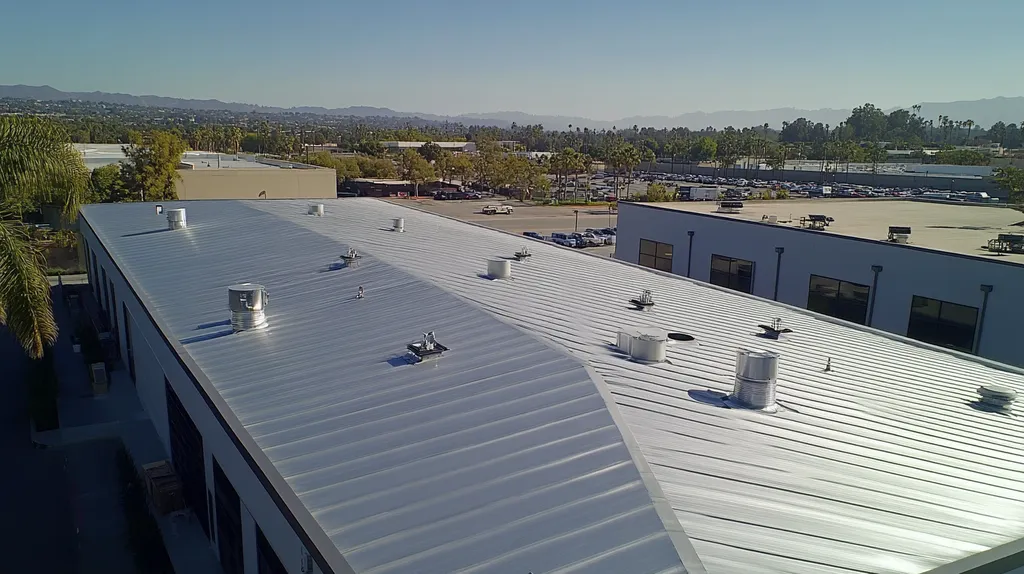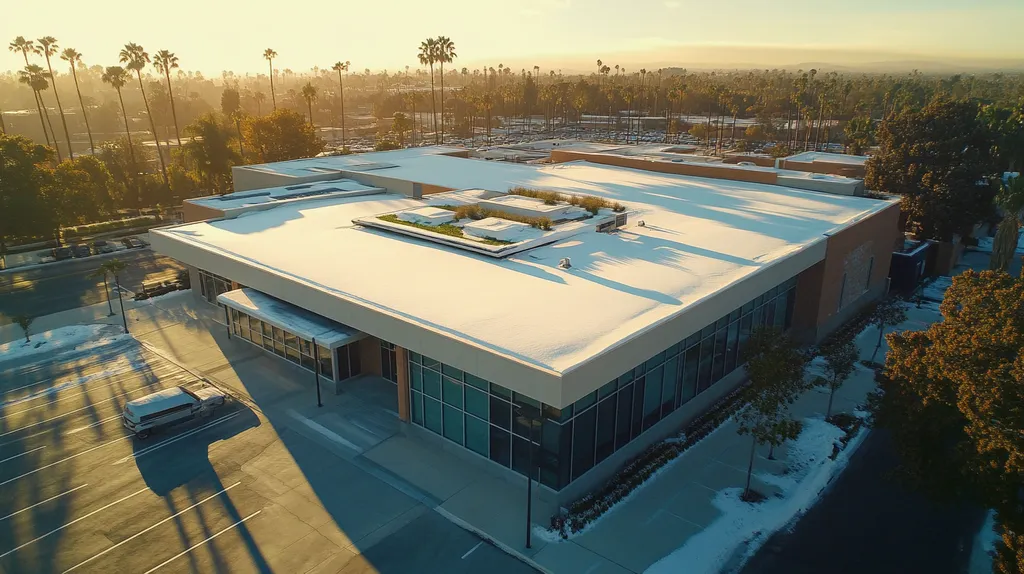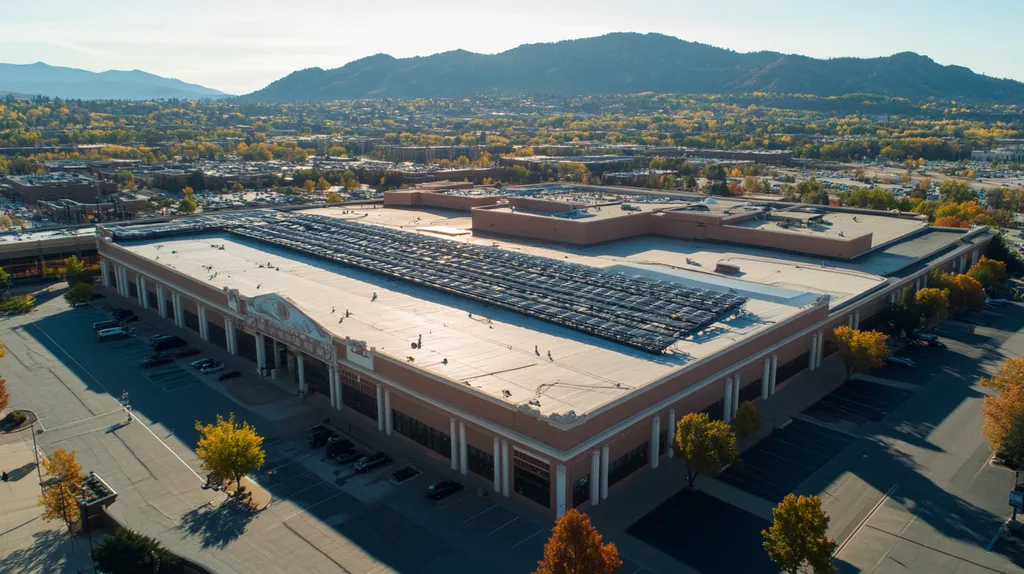Welcome to today’s Battle Royale featuring two roofing heavyweights: “TPO” in the east corner versus “PVC” in the west!
Tonight’s showdown pits these contenders against each other across six punishing rounds designed to test every aspect of their performance for Industrial Roof Repair Costs.
At stake? Millions in potential costs, decades of building protection, and the critical performance demands of modern commercial and industrial facilities.
Our professional judging panel will evaluate each round on technical merit, real-world performance, and value delivery. After all six rounds, we’ll declare our ultimate champion.
Ladies and gentlemen, facility managers and building owners… it’s time to rumble!
ROUND 1: INITIAL COSTS & INSTALLATION
When faced with industrial roof repairs, every dollar counts – and making the wrong choice between TPO and PVC can cost facility owners tens of thousands in unnecessary expenses. The selection of roofing material dramatically influences not just immediate costs, but also installation requirements and project duration. Understanding these three critical factors helps property managers make informed decisions that protect both their buildings and their budgets.
Material Expenses
The choice of roofing material represents one of the most significant cost factors in any commercial roofing project. (source: CRS Bama)
TPO materials typically cost 30-40% less than PVC alternatives, with standard TPO running $4-6 per square foot compared to PVC’s $7-9 per square foot. This difference becomes substantial on large industrial installations, where material costs can easily reach six figures.
While PVC offers superior chemical resistance and durability, its higher material cost presents a significant initial investment. For budget-conscious projects without specialized chemical resistance requirements, TPO’s lower cost point proves compelling.
Given the substantial price difference, TPO earns the clear “ADVANTAGE” in material expenses.
Installation Complexity
Installation complexity directly impacts labor costs and the potential for installation errors. TPO’s simplified welding process and lighter weight make it easier to handle and install, reducing both labor hours and specialized equipment needs.
PVC installation demands more precise welding temperatures and techniques, requiring specialized training and equipment. This increased complexity typically adds 15-25% to labor costs compared to TPO installations.
While both materials require professional installation, TPO’s simpler process reduces the risk of installation errors and speeds up the overall project. This translates to lower labor costs and fewer potential complications.
TPO claims the “ADVANTAGE” in installation complexity due to its more straightforward application process.
Project Timeline
Project duration significantly impacts both direct costs and business disruption. TPO installations typically complete 20-30% faster than equivalent PVC projects due to simpler handling and welding requirements.
PVC’s more demanding installation process extends project timelines, particularly in complex installations with multiple penetrations or detailed flashings. These longer timelines increase both labor costs and facility disruption.
Faster installation means TPO projects can often complete within shorter weather windows, reducing the risk of weather-related delays and complications. This speed advantage proves particularly valuable in regions with unpredictable weather patterns.
TPO secures another “ADVANTAGE” for enabling faster project completion and reduced business disruption.
ROUND 1 WINNER: TPO
ROUND 2: DURABILITY & LIFESPAN
In industrial roofing, the true cost of repair decisions extends far beyond initial installation. A premature roof failure can cascade into catastrophic expenses, with replacement costs for even small commercial buildings exceeding $80,000. (source: AAA Roofing)
Understanding how TPO and PVC materials perform over time isn’t just about avoiding leaks – it’s about protecting massive investments in facility infrastructure and operations. Let’s examine how these materials stack up in real-world durability challenges.
Material Resilience
TPO membranes showcase impressive resistance to UV radiation and common industrial chemicals. Their reinforced composition helps prevent tears and punctures, while the heat-welded seams create reliable waterproof barriers.
However, TPO’s performance can vary significantly between manufacturers. Some formulations show accelerated aging when exposed to extreme heat cycles, potentially requiring repairs or replacement within 10-15 years.
PVC membranes demonstrate exceptional chemical resistance and maintain their physical properties longer than TPO. Their proven track record spans decades, with many installations performing well beyond 20 years.
PVC gains the clear “ADVANTAGE” in material resilience due to its consistent long-term performance.
Weather Resistance
TPO membranes handle basic weather challenges effectively, reflecting UV rays and resisting water penetration. Their white surface maintains reflectivity well, helping manage building temperatures and reducing wear from thermal cycling.
Some TPO formulations can become brittle under prolonged exposure to extreme temperatures. This vulnerability may lead to cracking and premature failure in challenging climates.
PVC demonstrates superior resistance to temperature extremes and maintains its flexibility longer than TPO. Its chemical structure provides better resistance to environmental stressors and pollutants.
PVC claims another “ADVANTAGE” for its superior weather resistance capabilities.
Maintenance Requirements
TPO roofs typically require regular inspections and maintenance to achieve their full lifespan potential. Seam failures and surface degradation need prompt attention to prevent more serious issues.
The material’s lower chemical resistance may necessitate more frequent cleaning and repairs in industrial environments where chemical exposure is common.
PVC systems generally require less intensive maintenance to maintain their performance. Their superior chemical resistance and durable seams reduce the frequency of repairs and extend service intervals.
PVC earns the “ADVANTAGE” in maintenance requirements due to its lower long-term care needs.
ROUND 2 WINNER: PVC
ROUND 3: PERFORMANCE FACTORS
In the high-stakes world of industrial roofing, performance failures can trigger catastrophic chain reactions. A single roof leak can damage millions in equipment, halt production lines, and compromise worker safety. Understanding how roofing materials perform under real-world conditions isn’t just about preventing drips – it’s about protecting entire operations from devastating disruptions.
Durability and Longevity
TPO roofing systems demonstrate solid baseline durability, with typical lifespans ranging from 15-20 years in industrial environments. Their reinforced composition resists basic wear and tear, while heat-welded seams provide reliable waterproofing under normal conditions.
However, TPO’s performance can degrade faster than expected when exposed to harsh industrial conditions. Chemical exposure, extreme temperature cycling, and UV radiation can accelerate material breakdown, potentially requiring premature replacement.
PVC systems consistently deliver 20-30 year lifespans, even in challenging industrial settings. Their superior chemical composition maintains flexibility and structural integrity longer, while specialized formulations resist industrial pollutants that quickly degrade other materials.
PVC claims the clear “ADVANTAGE” in durability by delivering consistently longer service life under demanding conditions.
Insulation Properties
TPO’s reflective surface helps manage heat gain, but the material itself provides limited insulation value. Most installations require substantial additional insulation layers to meet energy efficiency goals, adding complexity and cost to the system.
The material’s thermal performance can degrade over time as surface contamination reduces reflectivity. This deterioration gradually increases cooling costs and stress on HVAC systems.
PVC membranes maintain their insulating properties longer and offer superior thermal resistance. Their molecular structure naturally resists heat transfer better than TPO, while specialized formulations can enhance these properties further.
PVC earns another “ADVANTAGE” for delivering superior long-term insulation performance.
Environmental Resistance
TPO provides adequate resistance to common environmental challenges like rain and moderate temperature changes. The material handles basic industrial pollutants reasonably well when properly maintained.
However, TPO shows vulnerability to concentrated chemical exposure and extreme weather events. Areas with high pollution levels or frequent temperature swings often see accelerated deterioration.
PVC excels in harsh environmental conditions, maintaining its protective properties even when exposed to aggressive industrial chemicals. The material’s superior flexibility helps it accommodate building movement and thermal shock without compromising integrity.
PVC secures the “ADVANTAGE” in environmental resistance through superior chemical and physical resilience.
ROUND 3 WINNER: PVC
ROUND 4: MAINTENANCE REQUIREMENTS
When industrial roof maintenance goes wrong, the consequences cascade through entire operations. A single delayed inspection can spiral into catastrophic failures, resulting in hundreds of thousands in equipment damage and production losses. Understanding the maintenance demands of different roofing systems isn’t just about scheduling routine checks – it’s about protecting critical business infrastructure from preventable failures.
Maintenance Frequency
TPO roofing systems demand vigilant attention, typically requiring comprehensive inspections every 4-6 months. These checks must carefully examine seams, flashings, and membrane surfaces for early signs of degradation or damage.
Environmental contaminants and UV exposure can accelerate TPO deterioration, often necessitating additional inspections after severe weather events or chemical exposures. This increased frequency strains maintenance budgets and staff resources.
PVC systems maintain their integrity longer, allowing for extended intervals between major inspections. Their superior chemical resistance and more durable seams typically reduce inspection requirements to annual or semi-annual checks.
PVC claims the “ADVANTAGE” in maintenance frequency due to its reduced inspection demands.
Repair Complexity
TPO repairs often require extensive preparation and precise execution, particularly around seams and penetrations. Even minor repairs demand careful attention to welding temperatures and techniques to prevent further damage.
The material’s sensitivity to installation conditions can complicate repair procedures, requiring specialized equipment and expertise. This complexity increases both repair costs and facility downtime.
PVC repairs generally prove more straightforward, with the material’s superior weldability allowing for faster, more reliable fixes. The more forgiving nature of PVC welding reduces the risk of repair failures.
PVC earns another “ADVANTAGE” through simpler, more reliable repair procedures.
Long-term Performance
TPO systems frequently show accelerated wear patterns as they age, particularly in areas exposed to harsh industrial conditions. This degradation can lead to increasing maintenance demands and repair frequency in later years.
The material’s varying quality between manufacturers can result in unpredictable maintenance needs, making it difficult to establish reliable long-term maintenance budgets.
PVC maintains consistent performance characteristics throughout its service life, with predictable maintenance patterns that facilitate better planning. Its superior chemical stability results in fewer surprise repairs and more reliable budgeting.
PVC secures the “ADVANTAGE” in long-term performance through more predictable maintenance requirements.
ROUND 4 WINNER: PVC
ROUND 5: SUSTAINABILITY CREDENTIALS
In today’s industrial roofing landscape, environmental impact carries both immediate and long-term financial consequences. With increasing regulations and corporate sustainability mandates, choosing the wrong roofing material can trigger compliance penalties exceeding $100,000 while damaging brand reputation and market position.
Beyond regulatory concerns, sustainable roofing choices directly impact facility operating costs through energy efficiency, waste reduction, and resource conservation. Understanding these factors helps facility managers protect both environmental and financial interests.
Environmental Impact
TPO roofing delivers exceptional energy efficiency through its highly reflective surface, reducing cooling costs by up to 30% in warm climates. Its manufacturing process generates fewer pollutants than alternative materials, while installation creates minimal waste.
The material’s lightweight nature reduces transportation emissions and structural load requirements. TPO’s chemical composition also eliminates the use of chlorine and other environmentally harmful substances.
PVC production generates concerning levels of dioxins and other harmful chemicals. While modern manufacturing has reduced these impacts, PVC’s environmental footprint remains significantly larger than TPO’s throughout its lifecycle.
TPO claims the clear “ADVANTAGE” in environmental impact through superior energy efficiency and cleaner production.
Recyclability and Waste
TPO membranes can be fully recycled at end-of-life, with many manufacturers operating take-back programs that process old material into new roofing products. The material’s chemical structure allows for efficient recycling without quality degradation.
Installation waste from TPO projects can be immediately recycled, reducing landfill impact. The material’s long lifespan also minimizes replacement frequency and associated waste generation.
While PVC is technically recyclable, the process requires specialized facilities and often proves economically impractical. Many PVC roofs ultimately end up in landfills, where they can take centuries to decompose.
TPO earns another “ADVANTAGE” through superior recyclability and waste reduction.
Energy Performance
TPO’s highly reflective surface maintains its energy-saving properties longer than other materials, reducing HVAC loads and associated carbon emissions. The material’s resistance to dirt and biological growth helps preserve these benefits throughout its service life.
Advanced TPO formulations can reflect up to 80% of solar radiation, dramatically reducing cooling requirements and urban heat island effects. This performance translates directly into reduced energy consumption and lower operating costs.
While PVC offers decent reflectivity initially, its surface tends to degrade faster than TPO, reducing energy efficiency over time. The material also requires more energy during manufacturing, increasing its overall carbon footprint.
TPO secures the “ADVANTAGE” in energy performance through superior long-term reflectivity and efficiency.
ROUND 5 WINNER: TPO
ROUND 6: SPECIALIZED APPLICATIONS
When industrial facilities require specialized roofing applications, the stakes soar exponentially. A manufacturing plant with caustic chemical processes, a food processing facility with strict contamination controls, or a data center with mission-critical cooling needs – each demands precisely engineered roofing solutions that align with their unique operational requirements.
Making the wrong material choice for these specialized applications can trigger catastrophic failures, resulting in millions in equipment damage, regulatory violations, and production losses. Understanding how TPO and PVC perform in these demanding scenarios becomes crucial for protecting both facilities and operations.
Chemical Resistance
TPO membranes offer moderate resistance to common industrial chemicals but show vulnerability to prolonged exposure to harsh solvents and petrochemicals. In facilities with aggressive chemical environments, TPO may require frequent repairs or premature replacement.
The material’s performance can degrade rapidly when exposed to concentrated industrial emissions or chemical spills. This vulnerability makes TPO a risky choice for facilities handling corrosive materials.
PVC demonstrates exceptional resistance to industrial chemicals, maintaining its integrity even under sustained exposure to harsh substances. Its molecular structure provides superior protection against oils, greases, and industrial pollutants.
PVC claims the clear “ADVANTAGE” in chemical resistance through superior material stability.
Temperature Extremes
TPO systems can struggle in environments with extreme temperature fluctuations. High-heat industrial processes or rooftop equipment can create localized hot spots that accelerate membrane degradation.
The material’s performance becomes less predictable as temperatures approach its upper limits, potentially leading to premature aging and increased repair frequency.
PVC maintains its physical properties across a broader temperature range, making it ideal for facilities with demanding thermal conditions. Its superior heat resistance and dimensional stability reduce the risk of temperature-related failures.
PVC earns another “ADVANTAGE” for superior performance under temperature extremes.
Load-Bearing Capacity
TPO membranes provide adequate support for basic rooftop equipment but may require additional reinforcement for heavy industrial installations. Their load-bearing capacity can diminish over time, particularly in areas subject to frequent foot traffic.
The material’s limited puncture resistance increases vulnerability around heavy equipment mounting points and high-traffic maintenance areas.
PVC systems deliver superior puncture resistance and maintain their structural integrity better under sustained loads. Their enhanced durability better accommodates industrial equipment installations and regular maintenance access.
PVC secures the “ADVANTAGE” in load-bearing applications through better long-term performance.
ROUND 6 WINNER: PVC
AND THE WINNER IS…
After six grueling rounds of technical analysis, with millions in facility costs hanging in the balance, we have our verdict!
In a dramatic 4-2 decision, PVC claims the championship belt through dominant performances in durability, maintenance, performance factors, and specialized applications!
PVC’s superior chemical resistance, longer lifespan, and exceptional performance under extreme conditions proved decisive in securing this victory. Its ability to maintain structural integrity while demanding less maintenance sealed its position as the heavyweight champion of industrial roofing.
But don’t count TPO out completely! This scrappy challenger showed impressive strength in initial costs and sustainability credentials. For facilities with tight budgets and standard industrial conditions, TPO remains a compelling contender that can deliver solid performance at a lower price point.
IMPORTANT NOTICE: Every facility faces unique challenges that can impact roofing material selection. Local climate conditions, specific industrial processes, and building characteristics all play crucial roles in determining the optimal solution. This analysis provides general guidance but cannot account for all variables. Always consult qualified roofing professionals who can evaluate your specific situation before making final decisions.
Ladies and gentlemen, in the high-stakes arena of industrial roofing, there’s no substitute for matching your facility’s unique requirements with the right material’s strengths. Choose wisely – your building’s future depends on it!
FREQUENTLY ASKED QUESTIONS
Q. What are the initial costs for commercial roof repairs?
A. The initial costs can vary significantly based on roofing materials chosen. TPO is generally 30-40% cheaper compared to PVC, with price differences impacting large projects considerably. A careful selection can save facility owners thousands in upfront expenses.
Q. How does durability affect industrial roof costs?
A. The lifespan and performance of roofing materials significantly impact long-term expenses. PVC typically lasts longer, often over 20 years, while TPO can degrade faster in harsh conditions, leading to earlier replacements and increased costs. Investing in durable materials can prevent costly repairs.
Q. What performance factors should I consider for a commercial roof?
A. Important performance factors include durability, insulation properties, and environmental resistance. These aspects determine how well the roof will maintain its integrity under real-world conditions and minimize long-term repair costs. Evaluate each material’s ability to handle your facility’s specific demands.
Q. How often should I maintain my industrial roof?
A. Maintenance frequency depends on the roofing material used. TPO requires inspections every 4-6 months, while PVC allows for longer intervals, typically annually. Regular inspections are crucial to catch small issues before they escalate into costly repairs.
Q. What is the sustainability impact of commercial roofing options?
A. The environmental impact varies between materials. TPO provides better energy efficiency and lower emissions during manufacturing. It’s fully recyclable, while PVC poses significant recycling challenges and environmental concerns. Choosing sustainable options can enhance your brand’s reputation and reduce costs.
Q. How does load-bearing capacity affect roof selection?
A. Load-bearing capacity is crucial for roofs that support equipment or foot traffic. PVC offers higher durability and better puncture resistance, making it ideal for heavy installations. Improper material selection can lead to premature failures and expensive repairs down the line.
Q. Which roofing material is better for specialized applications?
A. For specialized applications, PVC is typically better suited due to its superior chemical resistance and stability under temperature extremes. Facilities that handle harsh chemicals or have strict safety regulations benefit from PVC’s reliability, reducing risks and maintenance costs.











